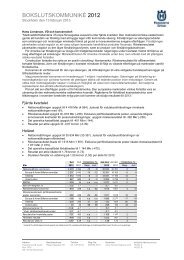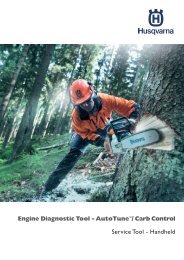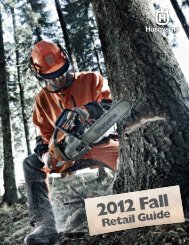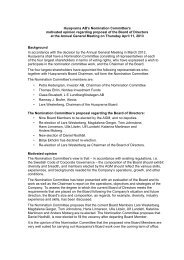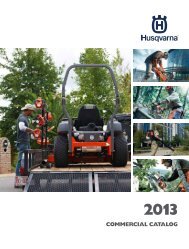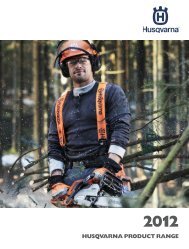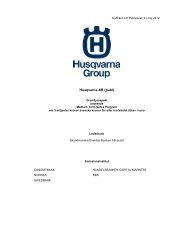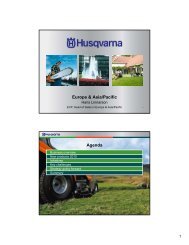Annual Report 2009 - Husqvarna Group
Annual Report 2009 - Husqvarna Group
Annual Report 2009 - Husqvarna Group
Create successful ePaper yourself
Turn your PDF publications into a flip-book with our unique Google optimized e-Paper software.
120 <strong>Husqvarna</strong> <strong>Annual</strong> <strong>Report</strong> <strong>2009</strong> Sustainable development<br />
In <strong>2009</strong> a new web-based reporting system for environmental<br />
data was implemented in all production centers and larger<br />
warehouses. This system will improve the quality of reported<br />
responses and improve the ability to compare performance<br />
between different plants within the <strong>Group</strong>.<br />
In connection with agreements to acquire companies or<br />
operations that have production facilities, <strong>Husqvarna</strong> analyzes<br />
environmental risks and observes Environmental Due Diligence<br />
(EDD). The analysis includes permits for operations, possible<br />
risk of ground pollution, and interviews with management.<br />
Inspections are normally performed by consultants with<br />
relevant expertise.<br />
Environmental risks<br />
Risks related to health, safety and the environment can arise at<br />
<strong>Husqvarna</strong>’s production facilities. The general environmental<br />
risks related to the <strong>Group</strong>’s operations include changes in customer<br />
or legal requirement for products, generating and handling<br />
emissions and waste, and potential environmental liabilities<br />
in connection with acquisition of land or production<br />
facilities.<br />
Transportation<br />
<strong>Husqvarna</strong> is committed to reducing the environmental impact<br />
that is generated when the <strong>Group</strong>’s products are shipped.<br />
The revised environmental policy includes more rigorous criteria<br />
for transportation in terms of safety and the environment.<br />
Forwarding companies are expected to actively contribute to<br />
reducing emissions of carbon dioxide, and to use systems for<br />
monitoring their activities. A project has been started for collection<br />
of environmental data from the major suppliers of shipping<br />
services to <strong>Husqvarna</strong>. These data include information on<br />
emissions of carbon dioxide in connection with all forms of<br />
transportation of <strong>Group</strong> products.<br />
Conserving resources<br />
Energy savings<br />
Building managers work continuously on optimizing the consumption<br />
of electricity. <strong>Husqvarna</strong> has made definite progress<br />
in reducing emissions of greenhouse gases on the basis of<br />
local projects for energy savings. For example, in Huskvarna<br />
Sweden, measures such as turning off fluorescent lamps during<br />
lunch hour, better control of ventilation equipment, sealing<br />
leaks in compressed air systems, reducing the indoor temperature<br />
etc. have reduced energy consumption by 7%.<br />
Travel<br />
Telephone-, video- and web-conferences have reduced the<br />
number of business trips by <strong>Husqvarna</strong> employees. This has<br />
resulted in more efficient use of working time, without any<br />
direct emissions from travel. Most trips by car, train and plane<br />
are monitored annually in terms of environmental impact,<br />
including emissions of carbon dioxide.<br />
Glossary<br />
FMEA – Failure Modes and Effects Analysis is a systematic<br />
method for predicting potential failures, evaluating<br />
their consequences and ranking proposed measures that<br />
could prevent them. FMEA is used in several areas,<br />
including quality-assurance management systems.<br />
ISO14001 – ISO’s international standard for environmental<br />
management. It includes requirements for regular environmental<br />
audits and gradual raising of target levels.<br />
REACH – Registration, Evaluation and Authorization of<br />
Chemicals – an EU-directive that requires testing of<br />
chemical substances used within the Union.<br />
RoHS – The EU-directive Restriction of Hazardous Substances<br />
regulates the use of mercury, cadmium, lead, sixvalent<br />
chrome and flame-resistant materials in electrical<br />
and electronic products.<br />
WEEE– The EU directive Waste Electrical and Electronic<br />
Equipment regulates the recycling of such products.



